Secrets of Mental Math by Arthur Benjamin (namjoon book recommendations TXT) 📖
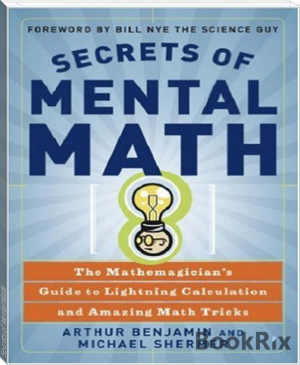
- Author: Arthur Benjamin
Book online «Secrets of Mental Math by Arthur Benjamin (namjoon book recommendations TXT) 📖». Author Arthur Benjamin
The subtraction method can also be used for three-digit numbers below a multiple of 100 or close to 1,000, as in the next two examples:
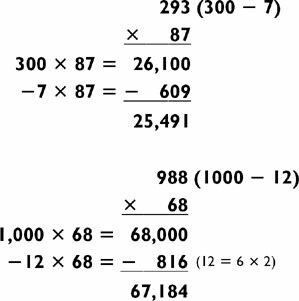
The last three digits of the answers were obtained by taking the complements of 609 − 100 = 509 and 816, respectively.
Finally, in the following illustration we break up the two-digit number using the subtraction method. Notice how we subtract 736 by subtracting 1,000 and adding back the complement:
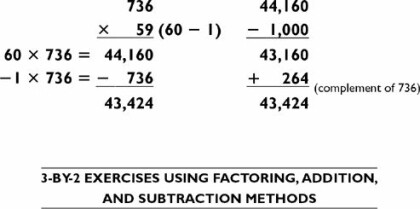
Solve the 3-by-2 problems below, using the factoring, addition, or subtraction method. Factoring, when possible, is usually easier. The solutions appear in the back of the book.
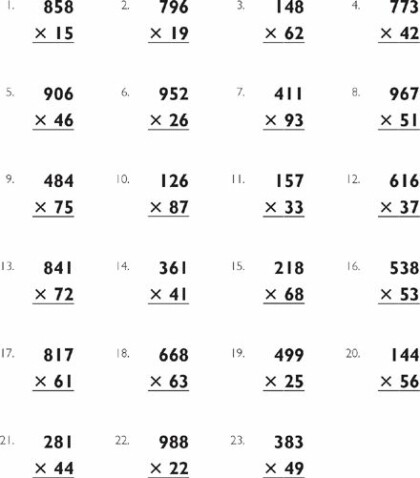
The following 3-by-2s will appear in the five-digit squares and the 5-by-5 multiplication problems that follow.
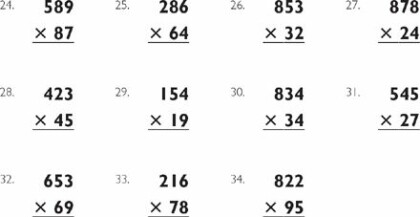
FIVE-DIGIT SQUARES
Mastering 3-by-2 multiplication takes a fair amount of practice, but once you’ve managed that, you can slide right into doing five-digit squares because they simplify into a 3-by-2 problem plus a two-digit square and a three-digit square. Watch:
To square the following number:
46,7922
Treat it as:

Using the distributive law we can break this down to:

This can be stated more simply as:
4622 1 million + (46)(792)(2000) + 79222
But I do not do them in this order. In fact, I start in the middle, because the 3-by-2 problems are harder than the two-digit and three-digit squares. So in keeping with the principle of getting the hard stuff out of the way first, I do 792 × 46 × 2 and attach three zeroes on the end, as follows:

Using the subtraction method, as shown above, compute 792 × 46 = 36,432, then double that number to get 72,864. Using the phonetic code from the last chapter on the number 864 allows you to store this number as 72 Fisher.
The next step is to do 462 × 1 million, which is 2,116,000,000.
At this point, you can say, “Two billion …”
Recalling the 72 of 72 Fisher, you add 116 million to get 188 million. Before saying this number aloud, you need to check ahead to see if there is a carry when adding Fisher, or 864, to 7922. Here you don’t actually calculate 7922; rather, you determine that its product will be large enough to make the 864,000 carry. (You can guesstimate this by noting that 8002 is 640,000, which will easily make the 864,000 carry, thus you bump the 188 up a notch and say, “… 189 million.… ”)
Still holding on to Fisher, compute the square of 792, using the three-digit square method (rounding up and down by 8, and so on) to get 627,264. Finally, add 627 to Fisher, or 864, to get 1,491. But since you already made the carry, drop the 1 and say, “… 491 thousand 264.”
Sometimes I forget the last three digits of the answer because my mind has been so preoccupied with the larger computations. So before doing the final addition I will store the 2 of 264 on my fingers and try to remember the 64, which I can usually do because we tend to recall the most recent things heard. If this fails, I can come up with the final two digits by squaring the final two digits of the original number, 922, or 8,464, the last two digits of which are the last two digits I’m looking for: 64. (Alternatively, you can convert 264 into a word like nature.)
I know this is quite a mouthful. To reiterate the entire problem in a single illustration, here is how I computed 46,7922:
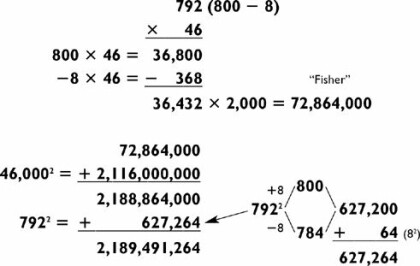
Let’s look at another five-digit square example:
83,5222
As before, we compute the answer in this order:
83 × 522 × 2,000, 832 × 1 million, then 5222
For the first problem, notice that 522 is a multiple of 9. In fact, 522 = 58 × 9. Treating 83 as 80 + 3, we get:

Doubling 43,326 results in 86,652, which can be stored as 86 Julian. Since 832 = 6,889, we can say, “Six billion …”
Adding 889 + 86 gives us 975. Before saying 975 million we check to see if Julian (652,000) will cause a carry after squaring 522. Guesstimating 5222 as about 270,000 (500 × 540), you see it will not carry. Thus you can safely say, “… 975 million …”
Finally, square 522 in the usual way to get 272,484 and add that to Julian (652,000) for the rest of the answer: “… 924,484.”
Illustrated, this problem looks like:
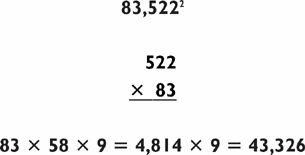


3-BY-3 MULTIPLICATION
In building to the grand finale of 5-by-5 multiplication, 3-by-3s are the final hurdle. As with 3-by-2s, there are a variety of methods you can use to exploit the numbers in the simplification process.
Factoring Method
We’ll begin with the factoring method. Unfortunately, most three-digit numbers are not factorable into one-digit numbers, but when they are, the calculation is not too bad.

Notice the sequence involved. You simplify the 3-by-3 (829 × 288) to a 3-by-1-by-1-by-1 through the factoring of 288 into 9 × 8 × 4. This then turns into a 4-by-1-by-1 (7,461 × 8 × 4), and finally into a 5-by-1 to yield the final answer of 238,752. The beauty of this process is that there is nothing to add and nothing to store in memory. When you get to the 5-by-1, you are one step away from completion.
The 5-by-1 problem can be solved in two steps by treating 59,688 as 59,000 + 688, then adding the results of the 2-by-1 (59,000 × 4) and the 3-by-1 (688 × 4), as below:

If both three-digit numbers are factorable into 2-by-1s, then the 3-by-3 can be simplified to a 2-by-2-by-1-by-1, as in the following problem:

As usual, it is best to get the hard part of the problem over first (the 2-by-2). Once you’ve got this, the problem is then reduced to a 4-by-1, then to a 5-by-1.
More often than not, only one of the three-digit numbers will be factorable, in which case it is reduced to a 3-by-2-by-1, as in the following problem:
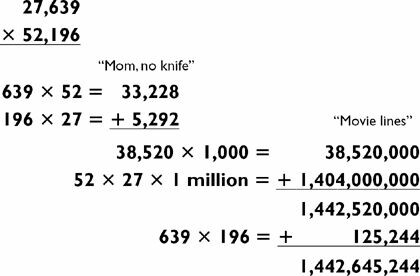
The next 3-by-3 is really just a 3-by-2 in disguise:

By doubling the 435 and cutting 624 in half, we obtain the equivalent problem:

Close-Together Method
Are you ready for something easier? The next multiplication shortcut, which we introduced in Chapter 0, is based on the following algebraic formula:
(x + a)(z + b) = z2 + za + zb + ab
Which we rewrite as:
(x + a)(z + b) = z(z + a + b) + ab
This formula is valid for any values of z, a, and b. We shall take advantage of this whenever the three-digit numbers to be multiplied (z + a) and (z + b) are both near an easy number z (typically one with lots of zeroes in it). For example, to multiply:

We treat this problem as (100 + 7)(100 + 11).
Using z = 100, a = 7, b = 11, our formula gives us:
100(100 + 7 + 11) + 7 × 11 = 100 × 118 + 77 = 11,877
I diagram the problem this way:

The numbers in parentheses denote the difference between the number and our convenient “base number” (here, z = 100). The number 118 can be obtained either by adding 107 + 11 or 111 + 7. Algebraically these sums are always equal since (z + a) + b = (z + b) + a.
With fewer words this time, here’s another quickie:
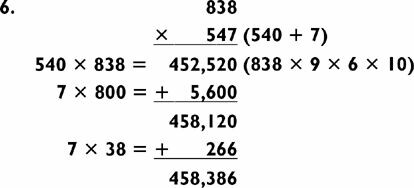
Neat!
Let’s up the ante a little with a higher base number:

Although this method is usually used for three-digit multiplication, we can use it for 2-by-2s as well:

Here, the base number is 70, which we multiply by 81 (78 + 3). Even the addition component is usually very simple.
We can also apply this method when the two numbers are both lower than the base number, as in the following problem where both numbers are just under 400:
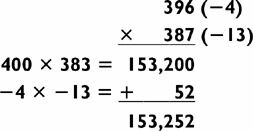
The number 383 can be obtained from 396 − 13, or from 387 − 4. I would use this method for 2-by-2 problems like the ones below:
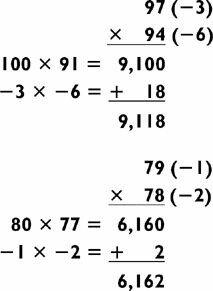
In our next example, the base number falls between the two numbers:
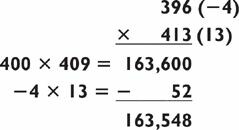
The number 409 is obtained from 396 + 13, or 413 − 4. Notice that since −4 and 13 are of opposite signs we must subtract 52 here.
Let’s raise the ante higher still, to where the second step requires a 2-by-2 multiplication:
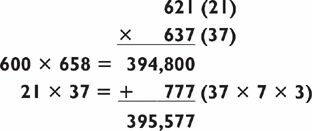
We note here that step 1 in the multiplication problem (600 × 658) is itself a reasonable estimate. Our method enables you to go from an estimate to the exact answer.
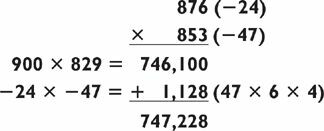
Also notice that in all these examples, the numbers we multiply in the first step have the same sum as the original numbers. For example, in the problem above, 900 + 829 = 1729 just as 876 + 853 = 1729. This is because:
x + [(x + a) + b] = (x + a) + (x + b)
Thus, to obtain the number to be multiplied by 900 (which you know will be 800 plus something), you need only look at the last two digits of 76 + 53 = 129 to determine 829.
In the next problem, adding 827 + 761 = 1588 tells us that we should simply multiply 800 × 788, then subtract 27 × 39 as follows:

This method is so effective that if the 3-by-3 problem you are presented with has numbers that are not close together, you can sometimes modify the problem by dividing one and multiplying the other, both by the same number, to bring them closer together. For instance, 672 × 157 can be solved by:
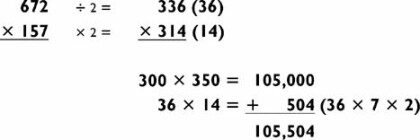
When the numbers being multiplied are the same (you can’t get any closer than that!), notice that the close-together method produces the exact same calculations you did in our traditional squaring procedure:

Addition Method
When none of the previous methods work, I look for an addition-method possibility, particularly when the first two digits of one of the three-digit numbers is easy to work with. For example, in the problem below, the 64 of 641 is factorable into 8 × 8, so I would solve the problem as illustrated:

In a similar way, in the next problem the 42 of 427 is factorable into 7 × 6, so you can use the addition method and treat 427 as 420 + 7:
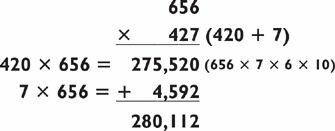
Often I break the last addition problem into two steps, as follows:
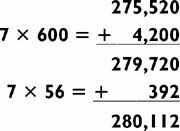
Since addition-method problems can be very strenuous, I usually go out of my way to find a method that will produce a simple computation at the end. For example, the above problem could have been done using the factoring method. In fact, that is how I would choose to do it:
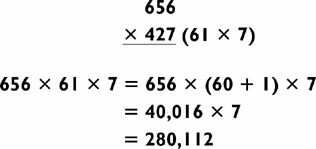
The simplest addition-method problems are those in which one number has a 0 in the middle, as below:
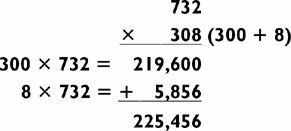
These problems tend to be so much easier than other addition-method problems that it pays to see whether the 3-by-3 can be converted to a problem like this. For instance, 732 × 308 could have been obtained by either of the “non-zero” problems below:

We mention that another way to do this problem is by 308 × 366 × 2, and take advantage of the closeness of 308 and 366. Let’s do one more toughie:
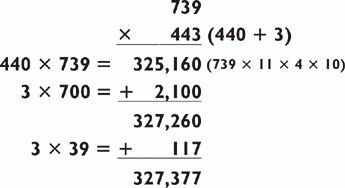
Subtraction Method
The subtraction method is one that I sometimes use when one of the three-digit numbers can be rounded up to a convenient two-digit number with a 0 at the end, as in the next problem:
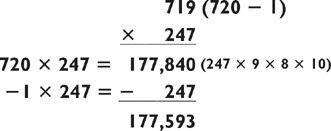
Likewise in the following example:
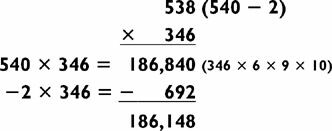
When-All-Else-Fails Method
When all else fails, I use the following method, which is foolproof when you can find no other method to exploit the numbers. In the when-all-else-fails method, the 3-by-3 problem is broken down into three parts: a 3-by-1, a 2-by-1, and a 2-by-2. As you do each computation, you sum the totals as you go. These problems are difficult, especially if you cannot see the original number. In my presentation of 3-by-3s and 5-by-5s, I have the problems written down, but I do all the calculations mentally.
Here’s an example:
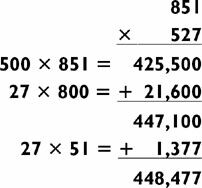
In practice, the calculation actually proceeds as shown below. Sometimes I use the

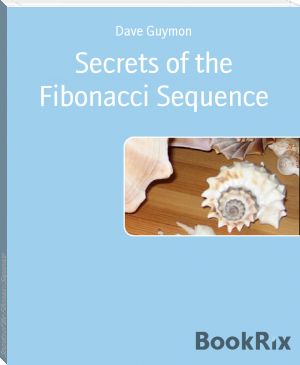


Comments (0)